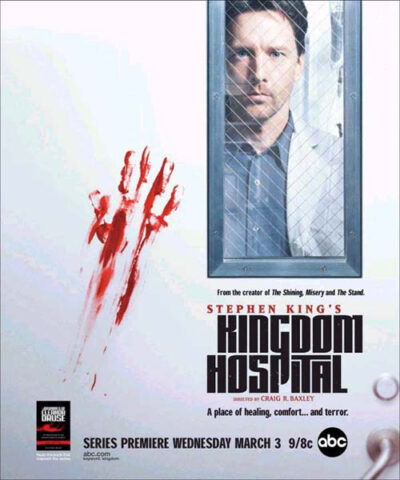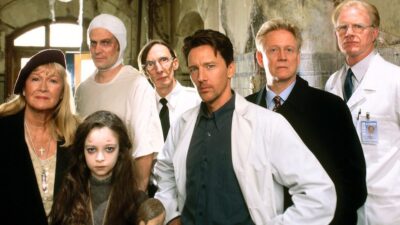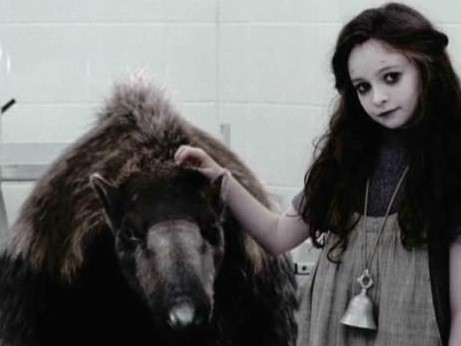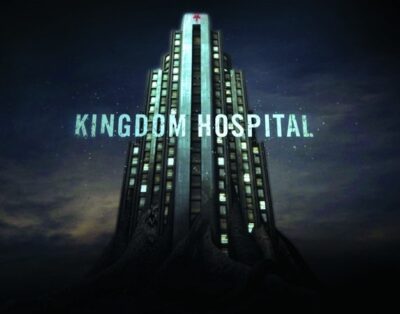 Back in 1991 Stephen King wrote “I still believe there’s a place on TV for long, complex stories—electronic novels, if you will—that exist in that medium alone and have a beginning, a middle, and an end. Who knows; maybe they will be some of the best-sellers of the 21st century.” Those “electronic novels” (distinct from King-adapted miniseries like SALEM’S LOT, IT and the two STANDs) began with the King scripted GOLDEN YEARS in 1991, and continued with STORM OF THE CENTURY in 1999, ROSE RED in 2002 and, most ambitiously, KINGDOM HOSPITAL in 2004. That ABC TV program’s finished form was, King has claimed, “the thing I like best out of all the things I’ve done,” although a “best seller” it definitely wasn’t.
Back in 1991 Stephen King wrote “I still believe there’s a place on TV for long, complex stories—electronic novels, if you will—that exist in that medium alone and have a beginning, a middle, and an end. Who knows; maybe they will be some of the best-sellers of the 21st century.” Those “electronic novels” (distinct from King-adapted miniseries like SALEM’S LOT, IT and the two STANDs) began with the King scripted GOLDEN YEARS in 1991, and continued with STORM OF THE CENTURY in 1999, ROSE RED in 2002 and, most ambitiously, KINGDOM HOSPITAL in 2004. That ABC TV program’s finished form was, King has claimed, “the thing I like best out of all the things I’ve done,” although a “best seller” it definitely wasn’t.
KINGDOM HOSPITAL’s basis was the first season of Lars Von Trier’s Danish TV series THE KINGDOM/Riget, from 1994 (with the second season arriving in 1997 and the long-belated third in 2022). A bizarre TWIN PEAKS-ish mixture of horror and hilarity, THE KINGDOM was based on actual occurrences in a Danish hospital, and visualized via once-innovative handheld camerawork that, paired with highly naturalistic performances, directly foreshadowed the Von Trier initiated Dogme-95 movement (whose output included Thomas Vinterberg’s THE CELEBRATION/Festen, Von Trier’s THE IDOTS/Idioterne and Harmony Korine’s JULIEN DONKEY-BOY).
King reportedly spent a half-decade pursuing the rights to the series. He’s spoken of watching closely as the numerous attempts by the program’s American rights holder Columbia Pictures to make a feature film from the series came to naught, with Columbia eventually granting King the rights in exchange for the novella SECRET WINDOW, SECRET GARDEN (which begat the 2004 Johnny Depp vehicle SECRET WINDOW).
King appears to have been unaware of ALL SOULS, a (very) short-lived KINGDOM inspired haunted hospital series from 2001. Co-executive produced by TWIN PEAKS’ Mark Frost, ALL SOULS managed just six poorly rated episodes before its plug was pulled. KINGDOM HOSPITAL had over twice as many episodes, with viewership that was stellar for the pilot episode but (in King’s words) “After that, watching the ratings was like watching a man walk down a set of suicide steps. We went from 5.5 to 3.7 to 2.3, finally bottoming out at something like a 1.0, which is basically the ratings equivalent of the Black Death.” A second season had reportedly been mapped out, but never saw production.
King’s script, prepared with the help of novelist Richard Dooling, hits all the beats of Von Trier’s KINGDOM, but draws out that admirably concentrated 4 episode program to a numbing 13 part whole. Also, in a sharp reversal of Hollywood remake protocol, KINGDOM HOSPITAL is actually weirder than its inspiration.
The setting is the Maine-based Kingdom Hospital. To Von Trier’s narrative about a ghost girl King added a toothy spectral anteater named Antubis (a play on Annubis) that can telepathically communicate with humans (all the animals in this program talk), a sentient headless corpse, references to Swedenborgian space, music numbers and other assorted weirdness. Sounds interesting, yes, but surreal comedy was never King’s forte.
King’s connection to the material is evident in the fact that he recreated his real-life 1999 accident, in which he was struck by a mini-van on a Maine road. His alter ego-protagonist, a famous artist named Peter Rickman (Jack Coleman), suffers an identical accident, which lands him in Kingdom Hospital. There we meet the virtuous Dr. Hook (Andrew McCarthy) and the not-so-nice Dr. Stegman (Bruce Davison, replacing THE KINGDOM’S Ernst-Hugo Järegård), who constantly rages about being away from his native Boston. Diane Ladd, who fares best acting-wise, turns up (in place of THE KINGDOM’S Kirsten Rolffes) as a quirky patient who makes contact with Mary (Jodelle Ferland), the aforementioned ghost girl.
 Mary was involved in a Civil War-era conflagration that razed a mill occupying the future site of Kingdom Hospital. It seems Mary was killed in the fire, but we eventually learn that she died afterward, in a far more horrific manner. As in THE KINGDOM, her ghost hangs out in the hospital elevator shaft and appears to anesthetized patients.
Mary was involved in a Civil War-era conflagration that razed a mill occupying the future site of Kingdom Hospital. It seems Mary was killed in the fire, but we eventually learn that she died afterward, in a far more horrific manner. As in THE KINGDOM, her ghost hangs out in the hospital elevator shaft and appears to anesthetized patients.
There’s also a pair of Down syndrome dishwashers (Brendon Bauer and Jennifer Cunningham) who get a bit more to do than THE KINGDOM’s Greek chorus washers, who were, I’d argue, far more memorable than their KINGDOM HOSPITAL counterparts. THE KINGDOM’S Down syndrome duo (Morten Rotne Leffers and Vita Jensen), whatever their narrative status, had some of the best dialogue in the series (“Some blood can be washed off and some blood cannot”).
One thing that wasn’t replicated from THE KINGDOM was KINGDOM HOSPITAL’s chaotic special effects heavy finale. CGI in 2004 hadn’t yet advanced to the point that it could be expected to carry an hour-long TV episode, yet that’s precisely what was asked of it. A wholly unreasonable request, as it turned out!
My insistence on KINGDOM comparisons may seem obnoxious, if not completely pointless, but the fact is that KINGDOM HOSPITAL makes no sense unless considered alongside its quintessentially European antecedent. That’s evident in Dr. Stegman’s constant whining about being exiled from his native land (Boston), a plot point that made more sense in THE KINGDOM, in which Ernst-Hugo Järegård’s Swedish doctor character was constantly raging about being forced to work in a different country (with the Swedish border visible from the roof of the Kingdom). So too the secret lodge meeting Järegård attends, in which he’s forced to pledge “enmity to the occult in all its forms,” i.e. the paganism of medieval Europe, and by way of initiation gets his nose sliced with a sword—things you probably won’t find in too many American lodge meetings, although that doesn’t stop King and director Craig R. Baxley from unconvincingly recreating the scene.
Baxley, a stunt coordinator and assistant director turned director (with credits that include the flicks ACTION JACKSON and STONE COLD, and the Stephen King TV projects STORM OF THE CENTURY and ROSE RED), was tasked with helming all thirteen episodes. A Herculean effort, to be sure, and Baxley pulled off the job well enough; his visuals are crisp and efficient, but lack the invention of THE KINGDOM, whose innovative camerawork was crucial to its impact.
Would a similarly unprecedented visual treatment have benefitted KINGDOM HOSPITAL? I’m not sure, but I am certain that Baxley’s straightforward staging does it no favors. In THE KINGDOM Von Trier’s extravagant direction actually accentuated the sense of day-to-day normality, whereas Baxley’s has the effect of enhancing the weirdness. As Stephen King once stated, “Without a concept of normality, there is no horror.” Nor is there any comedy, which is supposed to co-exist with the “horror” of KINGDOM HOSPITAL, but, to put it bluntly, doesn’t.
